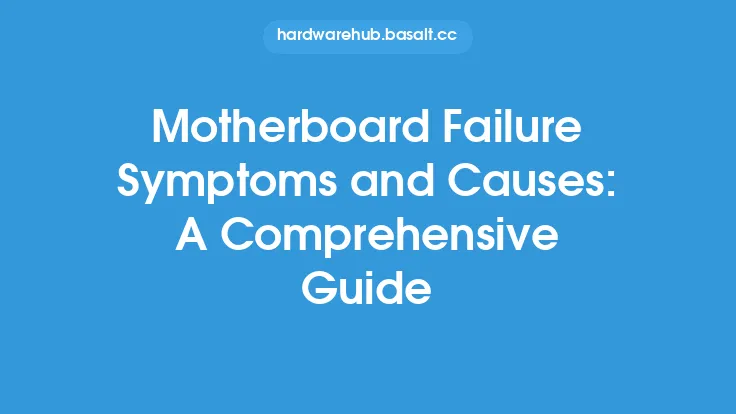Random Access Memory (RAM) is a crucial component of a computer system, responsible for temporarily storing data that the processor uses to perform tasks. However, like any other hardware component, RAM can fail, causing a range of problems for computer users. RAM failure can be caused by a variety of factors, including physical damage, overheating, and manufacturing defects. In this article, we will explore the causes, signs, and solutions for RAM failure, providing readers with a comprehensive understanding of this important topic.
Causes of RAM Failure
RAM failure can occur due to a range of factors, including physical damage, overheating, and manufacturing defects. Physical damage can occur when the RAM module is handled roughly, causing the pins or other components to become bent or broken. Overheating can also cause RAM failure, as high temperatures can damage the components on the RAM module. Manufacturing defects can also cause RAM failure, as faulty components or poor manufacturing processes can lead to premature failure. Additionally, power surges, electrical storms, and other forms of electrical interference can also cause RAM failure. It's also worth noting that RAM failure can be caused by compatibility issues, such as using RAM modules with different speeds or timings in the same system.
Signs of RAM Failure
The signs of RAM failure can vary, but common symptoms include system crashes, freezes, and errors. If the RAM is failing, the system may not be able to boot properly, or it may crash or freeze frequently. Error messages, such as "memory management" errors, may also appear. In some cases, the system may not be able to detect the RAM module at all, or it may detect it but be unable to use it properly. Other signs of RAM failure include data corruption, where files or programs become damaged or unusable, and slow system performance, where the system takes longer than usual to perform tasks. It's also worth noting that some systems may have built-in diagnostic tools that can detect RAM failure, such as the Windows Memory Diagnostic tool.
Solutions for RAM Failure
If the RAM is failing, there are several solutions that can be tried. The first step is to try reseating the RAM module, as this can sometimes resolve the issue. If the problem persists, the next step is to try replacing the RAM module with a new one. It's essential to ensure that the replacement RAM module is compatible with the system, as using incompatible RAM can cause further problems. In some cases, it may be possible to repair the faulty RAM module, such as by replacing a faulty component or cleaning the module to remove dust or debris. However, this is typically not recommended, as it can be time-consuming and may not be successful. It's also worth noting that some systems may have redundant RAM, where multiple RAM modules are used to provide fault tolerance. In these systems, the faulty RAM module can be removed and replaced without affecting system operation.
Preventing RAM Failure
While RAM failure can be unpredictable, there are several steps that can be taken to prevent it. One of the most effective ways to prevent RAM failure is to handle the RAM modules with care, avoiding physical damage or rough handling. It's also essential to ensure that the system is properly cooled, as overheating can cause RAM failure. Regular cleaning of the system, including the RAM modules, can also help to prevent failure by removing dust and debris. Additionally, using high-quality RAM modules from reputable manufacturers can help to reduce the risk of failure. It's also worth noting that some systems may have features such as error-correcting code (ECC) RAM, which can detect and correct errors in real-time, helping to prevent data corruption and system crashes.
RAM Failure in Different Systems
RAM failure can occur in a range of systems, from desktop computers to laptops and servers. In desktop computers, RAM failure can cause system crashes, freezes, and errors, and can be diagnosed using tools such as the Windows Memory Diagnostic tool. In laptops, RAM failure can be more difficult to diagnose, as the RAM modules are often soldered to the motherboard. In servers, RAM failure can be critical, as it can cause downtime and data loss. In these systems, redundant RAM and error-correcting code (ECC) RAM are often used to provide fault tolerance and prevent data corruption. It's also worth noting that some systems, such as those used in industrial or embedded applications, may have specialized RAM modules that are designed to withstand harsh environments and provide high levels of reliability.
Conclusion
RAM failure is a common problem that can cause a range of issues for computer users. By understanding the causes, signs, and solutions for RAM failure, readers can take steps to prevent and diagnose this problem. Whether it's reseating the RAM module, replacing it with a new one, or using specialized diagnostic tools, there are several solutions that can be tried. By taking a proactive approach to RAM maintenance and troubleshooting, readers can help to ensure that their systems run smoothly and efficiently, and that they can avoid the frustration and downtime caused by RAM failure.





